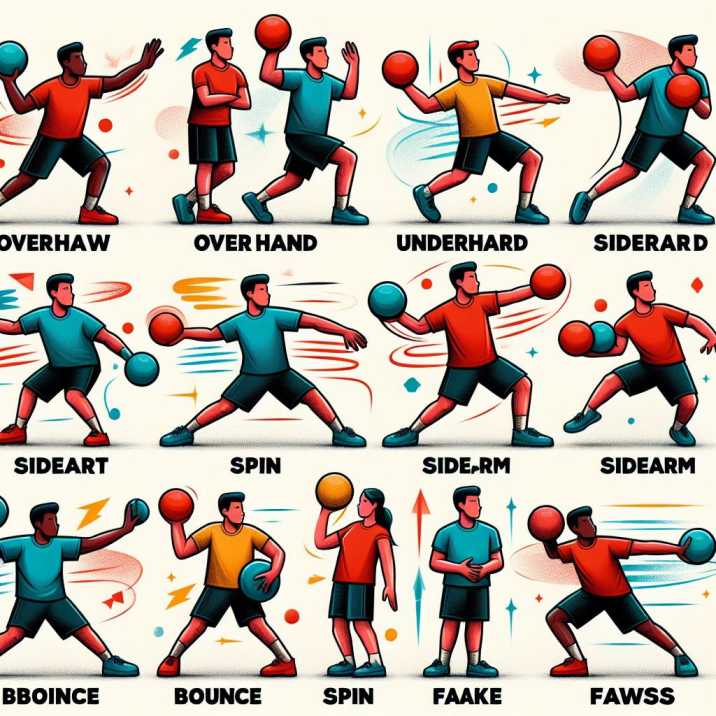Introduction:
Table of Contents
Dodgeball, a thrilling and fast-paced game, requires not only agility and teamwork but also mastery of various throwing techniques. From classic overhand throws to tricky curveballs, understanding the different types of throws can give players an edge on the court. In this guide, we’ll delve into the diverse array of throws in dodgeball, exploring their mechanics, advantages, and how to execute them effectively.

Types of throws in Dodgeball:
1. Overhand Throw:
The overhand throw is the most common and straightforward technique in dodgeball. Players use this throw by extending their arm overhead and releasing the ball in a forward motion towards their target. This throw is valued for its speed and accuracy, making it a staple in every dodgeball player’s arsenal.
2. Underhand Throw:
In contrast to the overhand throw, the underhand throw involves releasing the ball from below the waist. Players execute this throw by swinging their arm in an upward motion, propelling the ball towards the target. While not as fast as the overhand throw, the underhand throw offers greater control and accuracy, making it an effective strategy in certain situations.
3. Sidearm Throw:
The sidearm throw is characterized by a horizontal arm movement, with the ball released from the side of the body. This technique offers a unique angle of attack, catching opponents off guard with its unexpected trajectory. While mastering the sidearm throw may take practice, it can be a powerful tool for skilled dodgeball players.
4. Spin Throw:
The spin throw adds an element of spin to the ball, causing it to curve or dip unpredictably in flight. Players achieve this effect by applying spin with their wrist as they release the ball. The spin throw is particularly effective for bypassing defenders and targeting hard-to-reach opponents, making it a valuable skill in dodgeball strategy.
5. Bounce Throw:
The bounce throw involves bouncing the ball off the ground before it reaches the target. This technique can catch opponents off guard by altering the ball’s trajectory and making it more challenging to catch or dodge. Skilled players can use the bounce throw to exploit gaps in the opposing team’s defense, adding an element of unpredictability to their gameplay.
6. Fake Throw:
While not a traditional throwing technique, the fake throw is a strategic maneuver used to deceive opponents. Players simulate the motion of a throw without releasing the ball, tricking their opponents into reacting prematurely. Mastering the fake throw can create openings in the opposing team’s defense, allowing players to capitalize on their reactions.

Table of Information:
| Type of Throws in Dodgeball | Description |
|---|---|
| Overhand Throw | Classic technique, fast and accurate. |
| Underhand Throw | Controlled throw from below the waist. |
| Sidearm Throw | Horizontal arm movement for unexpected angle. |
| Spin Throw | Adds spin for curve or dip in flight. |
| Bounce Throw | Bounces off the ground to alter trajectory. |
| Fake Throw | Strategic maneuver to deceive opponents. |
Conclusion:
Mastering the various types of throws in dodgeball is essential for success on the court. From the classic overhand throw to the deceptive fake throw, each technique offers its own advantages and challenges. By understanding the mechanics and practicing different throwing techniques, players can enhance their skills and contribute to their team’s victory. So, grab a ball, hone your throwing skills, and dominate the dodgeball court with precision and finesse!
Frequently Asked Questions (FAQs):
1. What is the most common throwing technique in dodgeball?
- The overhand throw is the most common technique, valued for its speed and accuracy.
2. How can I improve my throwing accuracy in dodgeball?
- Practice regularly, focus on your throwing mechanics, and experiment with different techniques to find what works best for you.
3. Are there any advanced throwing techniques in dodgeball?
- Yes, advanced techniques such as the spin throw and bounce throw add complexity and unpredictability to your throws, requiring skill and practice to master.
4. How can I defend against opponent’s throws in dodgeball?
- Stay alert, use quick reflexes to dodge incoming throws, and work with your teammates to cover each other’s positions effectively.
5. Can I use fake throws to deceive my opponents in dodgeball?
- Yes, mastering the art of the fake throw can create openings in the opposing team’s defense, allowing you to gain a strategic advantage on the court.


